 Technology
Technology  Technology
Technology  Humans
Humans 10 Everyday Human Behaviors That Are Actually Survival Instincts
 Animals
Animals 10 Animals That Humiliated and Harmed Historical Leaders
 History
History 10 Most Influential Protests in Modern History
 Creepy
Creepy 10 More Representations of Death from Myth, Legend, and Folktale
 Technology
Technology 10 Scientific Breakthroughs of 2025 That’ll Change Everything
 Our World
Our World 10 Ways Icelandic Culture Makes Other Countries Look Boring
 Misconceptions
Misconceptions 10 Common Misconceptions About the Victorian Era
 Mysteries
Mysteries 10 Strange Unexplained Mysteries of 2025
 Miscellaneous
Miscellaneous 10 of History’s Most Bell-Ringing Finishing Moves
 Technology
Technology Top 10 Everyday Tech Buzzwords That Hide a Darker Past
 Humans
Humans 10 Everyday Human Behaviors That Are Actually Survival Instincts
 Animals
Animals 10 Animals That Humiliated and Harmed Historical Leaders
Who's Behind Listverse?

Jamie Frater
Head Editor
Jamie founded Listverse due to an insatiable desire to share fascinating, obscure, and bizarre facts. He has been a guest speaker on numerous national radio and television stations and is a five time published author.
More About Us History
History 10 Most Influential Protests in Modern History
 Creepy
Creepy 10 More Representations of Death from Myth, Legend, and Folktale
 Technology
Technology 10 Scientific Breakthroughs of 2025 That’ll Change Everything
 Our World
Our World 10 Ways Icelandic Culture Makes Other Countries Look Boring
 Misconceptions
Misconceptions 10 Common Misconceptions About the Victorian Era
 Mysteries
Mysteries 10 Strange Unexplained Mysteries of 2025
 Miscellaneous
Miscellaneous 10 of History’s Most Bell-Ringing Finishing Moves
10 Recent Weapon Discoveries That Add To Archaeology
Weaponry has been with mankind ever since the first human ancestor picked up a rock. Throughout history, it remained one of the most actively developed technologies, flavored by different cultures and times. The study of devices, injuries, and battlefields regularly return missing or unknown pieces to the human story that is archaeology. Ancient weapons can show how people adapted, correct misconceptions, and explain long-standing mysteries.
10The Glass Spearhead
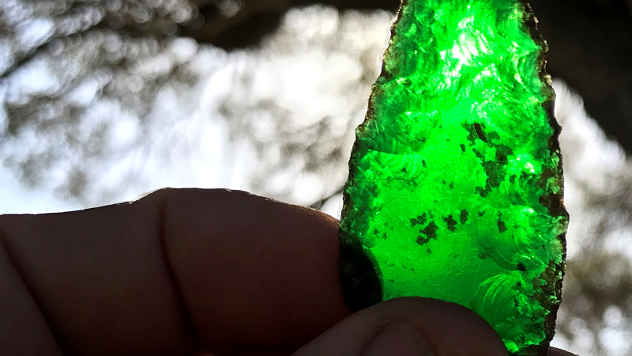
Over a century ago, male Aboriginal prisoners were sent to Australia‘s Rottnest Island.[1] Recently, the island was visited by University staff and students from Western Australia’s School of Indigenous Studies. While learning about the area’s history, one student found a beautiful artifact—a spearhead knapped from green glass. The rare point was about 100 years old and joined previous finds of other glass and ceramic spearheads. What makes this one unique is the deep, sparkling emerald shade. Every other glass point collected over the years was of the usual clear kind.
The weapons are believed to have been used by the Aboriginal inmates to forge bonds, a form of currency during the trading of goods, and to hunt quokkas. It appears the men chose a hilltop overlooking the mainland and went there to craft the spears from any glass they could salvage. The discovery shows the remarkable adaptability of the prisoners despite being incarcerated.
9Tooth Tools
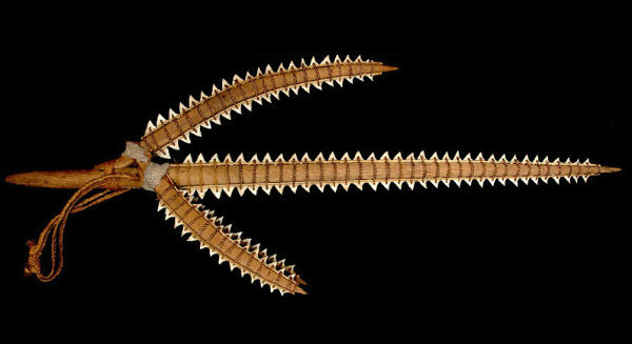
The Gilbert Islanders from the Pacific Ocean once made weapons from two vanished species.[2] The habit of using shark teeth to create vicious and inventive fighting tools was first noted by European arrivals in the 1700s. The Islanders drilled holes into each serrated snapper and tied them into position with human hair and coconut fibers. Researchers studied a scary collection at the Field Museum of Natural History in Chicago, to see which sharks were hunted for this art form that stopped 130 years ago. The idea was to see if any unknown species roamed the reefs before the age of census taking.
Thanks to the preserved weapons, they identified the silky shark, tiger, hammerhead, oceanic whitetip, and blue shark. The most heavily used was the silvertip shark. However, the true damage of over-fishing came to light when the team found the teeth of spotfin and dusky sharks. While they still exist elsewhere, neither have ever been recorded near the Gilbert Islands. What sealed their fate in this region was likely the shark-finning business that decimated populations for decades since 1900.
8Ancient .44 Magnum
At its peak, Rome walked over several countries, but Scotland was not one of them.[3] Described as “Rome’s Afghanistan,” the locals’ geographical knowledge proved to be a formidable advantage against the invaders. Evidence of how Roman soldiers went all out to subdue one group of Scots came to light at a 1,900-year-old fortified hill called Burnswark.
Using metal detectors, researchers found over 400 lead balls fired by slingshots. Experiments in Germany proved that a trained Roman slinger could have released the 50-gram bullets at a speed similar to a .44 magnum cartridge. Targets within 130 yards and some lengths beyond were not safe from expert throwers.
When archaeologists looked at the original positions of the bullets, two locations held them in abundance. The whole 500-yard-long rampart of the fort was peppered with the balls, fitting with the pattern of a long siege. A smaller concentration to the north could be where the Scots tried, but failed, to escape, since researchers believe there were no survivors and that many were felled by Roman slingshots.
7Kaakutja’s Wounds

Kaakutja is a skeleton allowing an extremely rare look at Aboriginal conflict before the arrival of the Europeans.[4] The 800-year-old man was found a few years ago in Toorale National Park, buried in the fetal position. Kaakutja’s life was short and violent. When he died, he was 25-35 years old and had already survived two head injuries. Another wound, this time unhealed, revealed a rarely seen demise—death by boomerang attack.
A six inch (15cm) long slice marred the right side of his face. The cut matched a metal blade’s damage, but this was six centuries before Europeans introduced metal weapons to Australia. Researchers concluded that Kaakutja succumbed in an attack where a less familiar kind of boomerang was used. Not the sort that returns to the thrower, it was larger and sabre-like with a deadly inner edge. This hand-held boomerang could cause the same serious damage as a sword, and in Kaakutja’s case, it happened so fast he could not defend himself, as no defensive injuries were found on the skeleton.
6Fighter Pharaohs
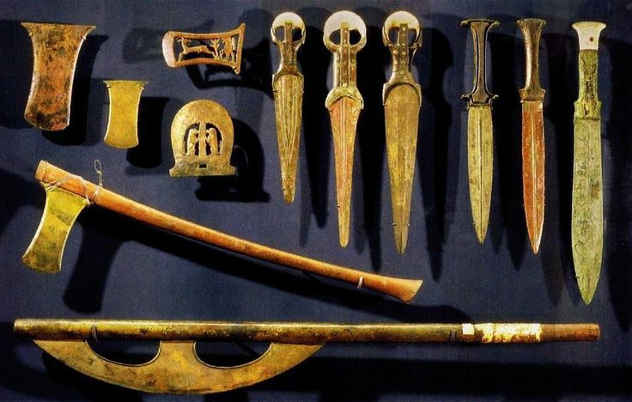
All records concerning weapons carried by Pharaohs state they were purely ritualistic.[5] However, new studies have found that not every item was just for show. Some of the ornate swords and axes might have been wielded by the Pharaohs and other elite Egyptians in battle.
Scientists chose 125 artifacts from Egypt’s Bronze Age, 5,000-3,000 years ago. Despite being called ritualistic, nearly all the weapons were forged as the real deal and very capable of fighting. Around half showed signs of active duty, although it is hard to say what they were used for. Apart from the battlefield, experts suspect some were used by the elite to execute prisoners or perform animal sacrifices.
One dagger that was definitely not a prop is thought to have belonged to Kamose, son of the murdered Pharaoh Seqenenre Tao II. It is unknown whether the vicious ax blows that felled the king happened on the battlefield or elsewhere during an assassination. Afterward, Kamose continued to fight the Hyksos, his father’s enemy and killers. The dagger’s blade bore traces of extensive use. Given the violent times and what happened to his father, researchers speculate it could have been used in combat.
5Easter Island’s Mata’a

A curious weapon hails from Easter Island, which is famous for its moai statues.[6] Called mata’a, it is a three-sided stabbing tool made from obsidian.
Just over 100 Rapanui natives remained by 1877 when they started sharing their past with Europeans. The tale told is of a devastated environment, scarce resources, and continuous fighting that destroyed their society. The story became fact, including that the mata’a was the weapon that brought bloodshed to the isolated population.
However, recent skeletal studies proved that scarcely any deaths resulted from mata’a assaults. More died after being pummeled with rocks. There is no evidence to support the stories of massacres either. There is a chance they never occurred, and that the mata’a was deliberately designed not to be too dangerous. For people who engineered the moai, the Islanders were capable of inventing worse weapons if they truly wanted war. This new look at the obsidian tools could reveal the true story of how the Rapanui instead decided to curb their volatile relationships before it killed everyone on the tiny island.
4Genghis Khan’s Secret Weapon

Eight centuries ago, an obscure tribe rose to conquer an unprecedented amount of territory.[7] How the Mongol hordes, a squabbling and divided people, came together to defeat most of Asia is a mystery. Tree-ring scientists are now suggesting that their secret weapon was as simple as unusual weather. After studying Siberian pines in central Mongolia, the trees showed something contrary to the traditional view that the Mongols spread because they wanted to escape their arid homeland.
Growth rings from 1211-1225, when Genghis Khan rose, showed that for 15 straight years, rains came to the usually frigid and dry steppes. The resulting lush fields increased the Mongols’ herds. The boom in livestock helped lessen internal conflict over resources, and the charismatic Khan grabbed the opportunity to unite the tribes into one power focused on conquest. Their war horses also increased, which was the driving force behind their strong armies. The change in climate strongly suggests that history could have been very different if the 15-year rain spell never occurred.
3The Iraqi Neanderthal
Iraq’s Zagros Mountains delivered the remains of nine Neanderthals between 1953-1960.[8] One middle-aged man’s remains bore a serious injury, rare evidence of inter-species aggression. Weeks before his death, he suffered a stabbing event that deeply cleft his left ninth rib. Theories included a fall, hunting accident, even a brawl with a fellow Neanderthal. However, weapon studies and experiments suggested that it was not another of his kind that took issue with him, but a human.
The age of Shanidar 3, as the victim was named, roughly matched with when modern humans returned to the area, around 50,000 years ago. By then, humans possessed throwing spears while Neanderthals had jabbing sticks. Both groups also owned stone knives. Neanderthals were eliminated as suspects when it was discovered that their thrusting spears would have caused more damage, and that a downward stab with a knife held the right trajectory but not the right speed to match the rib scar. The closest match was a thrown spear, traveling at a low momentum and hitting the standing Shanidar 3 at a 45 degrees downward angle.
2Trigger Factory
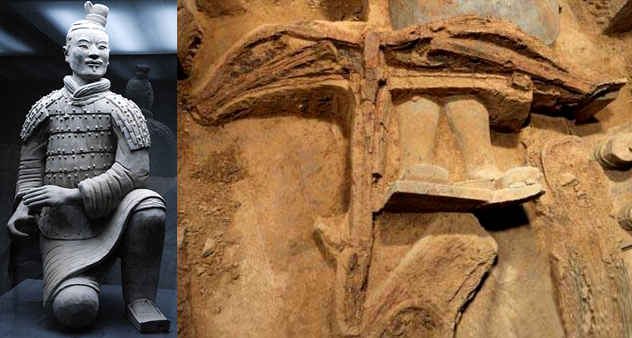
In the 1970s, the tomb of Emperor Qin Shi Huang was opened.[9] Best known for its terra-cotta army of life-size human figures, researchers puzzled over the statues’ weapons. Apart from stone armor, the soldiers also had swords, lances, and crossbows. Their construction remained a riddle, especially the crossbows. Their frames of wood and bamboo already decomposed, leaving behind metal parts such as tips and triggers. Each trigger had five interlocking pieces, and many experts felt an assembly line process was involved, but scrutiny dismissed this. The parts were near identical, meaning molds were used.
The structure of the workforce probably mirrored the way the Emperor reformed ancient China’s entire society. The population was broken into small groups collectively responsible for the obedience and productivity of its members. Similarly, the triggers were produced by groups of craftsmen assigned a particular task such as smelting or assembling. Since this was probably how weaponry destined for real conflict was also produced, such worker cells could have moved with armies to keep the soldiers’ weapons in working shape.
1Fake Viking Swords
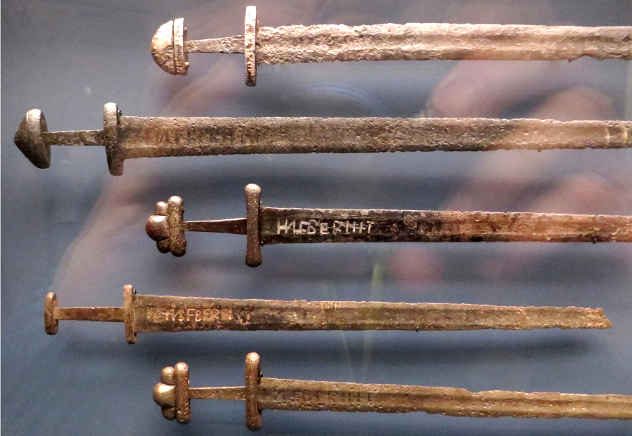
Back in the day, every self-respecting Viking fought with a designer sword.[10] The most sought-after were forged by Ulfberht, whose name was embossed near the hilt. Vikings produced superb swords but, much like today, inferior products fooled many buyers.
Experts never knew about this interesting piece of Viking history until a private collector brought an Ulfberht to the Wallace Collection, a museum in London. Comparing it to Ulfberht’s from its own and other collections, tests quickly exposed the difference. While both groups carried the famous name, were razor sharp, and appeared identical, the weaker fakes showed their nature at the worst moment. They broke easily, and several were found shattered on battlefields. Their iron came from northern Europe unlike the genuine swords, made of crucible steel from the Middle East with a carbon content three times higher. The fakes probably escaped detection because they were manufactured with expertise, but hardening the hot, inferior iron by plunging it into water made the blade brittle. Many well-known Ulfberhts in modern collections have now been revealed to be ancient impostors.
Read more about ancient weapons on 10 Badass Ancient Weapons From Around The World and 10 Insane Ancient Weapons You’ve Never Heard Of.








